*This post has been updated with more recent photos, because plants take their merry old time growing, and it’s a lot more fun when there are updates*
We snuck in a fun little project that I’ve been dying to try for, oh 10 years now. Behold: our DIY wire vine diamond trellis.
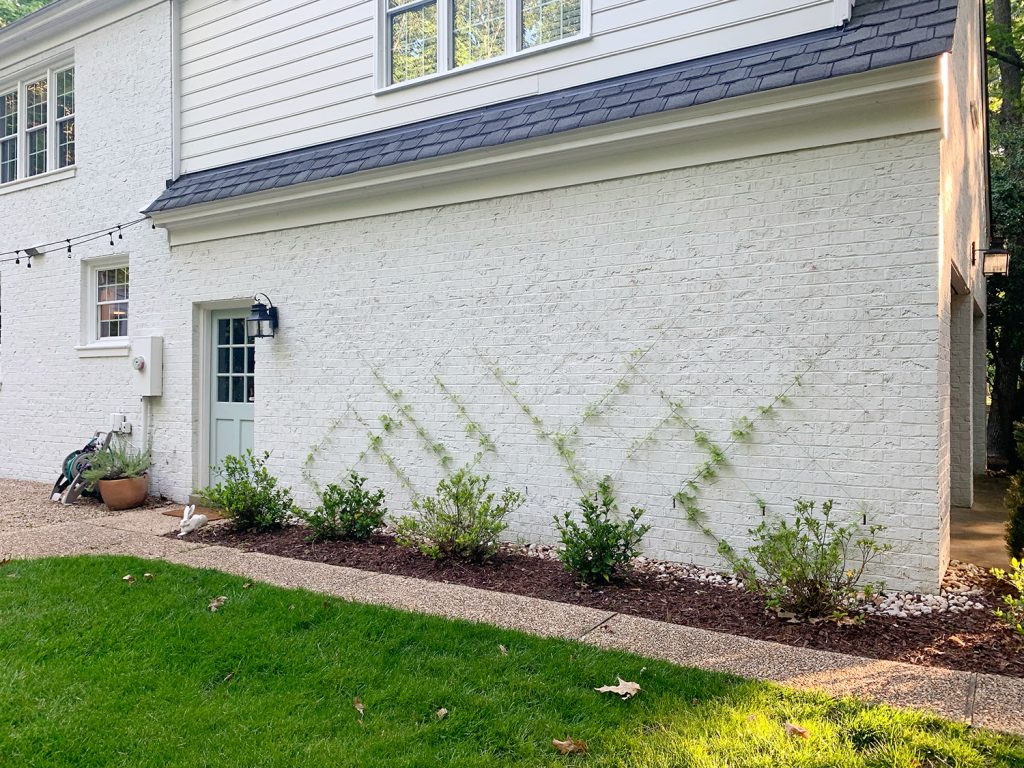
We’ve wanted to try our hand at one for a while. Actually the first time I thought “yeah, I want that” was back in 2009 when I saw one on the outside of this house that we crashed (yes, that’s 10 years ago! Even though 1999 sounds like 10 years ago in my head). I wish we had captured a picture of it for that post, but there was blotchy sunlight on it so it didn’t make the final cut. But that family still lives in that house, that diamond trellis continues to thrive, and I continue to gasp at it every time we walk by.
Which is how you end up posing in front of your own DIY diamond trellis like this. It’s a slippery slope.
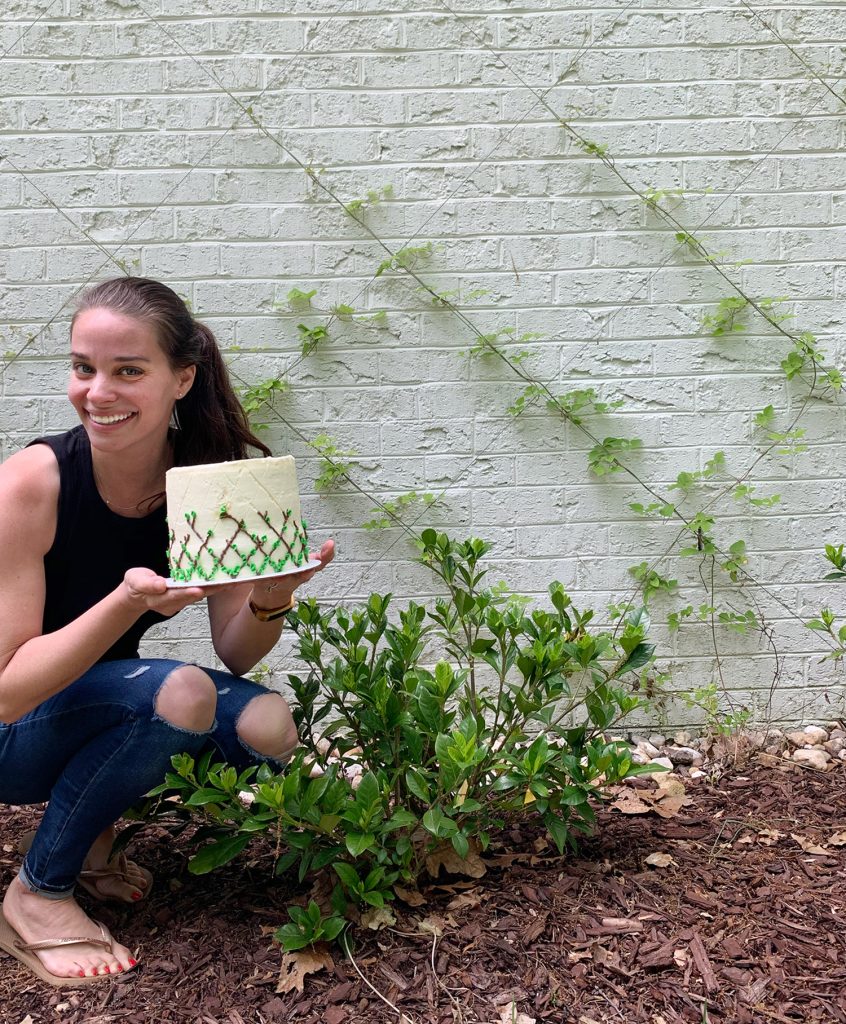
The Diamond Trellis Urge (let’s capitalize it because it has grown into a legitimate condition for me over the years) got even stronger after we painted our house white last fall. It’s just such a perfect blank canvas for some lush flowering vines. You may have even seen a couple of spectacularly bad renderings of me drawing a diamond trellis on the big white wall on the right of this photo last year on my InstaStories.
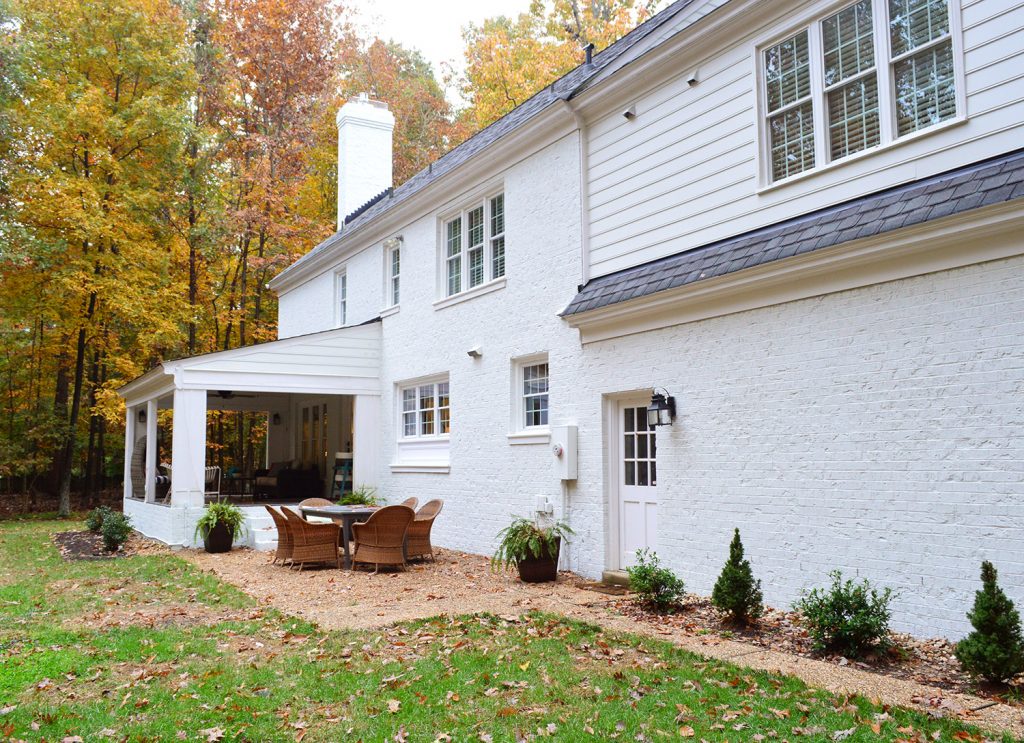
And now that strong whole-body craving has been satisfied… because MOMMA HAS A DIAMOND TRELLIS.
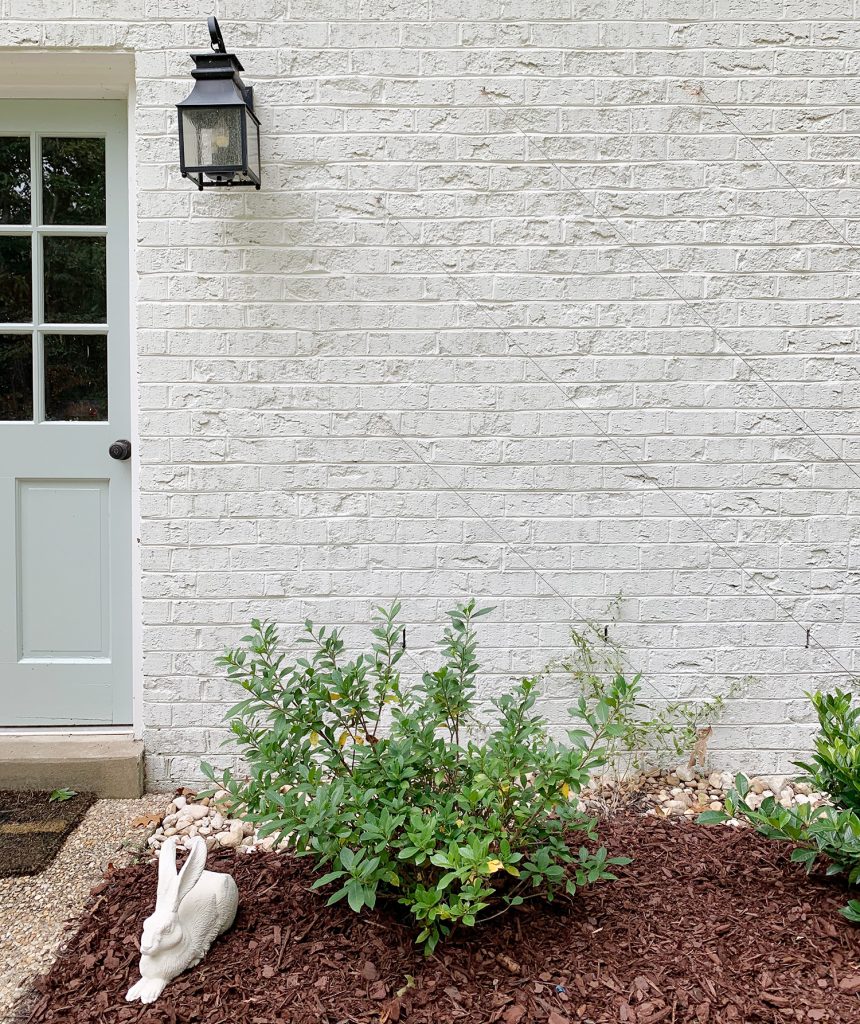
I know, I know, you have to squint to even see it in that photo above. But thanks to the magic of updated pictures, here’s what it looked like 6 months later. I snapped these updated photos right before we moved to Florida (more on that here and here).
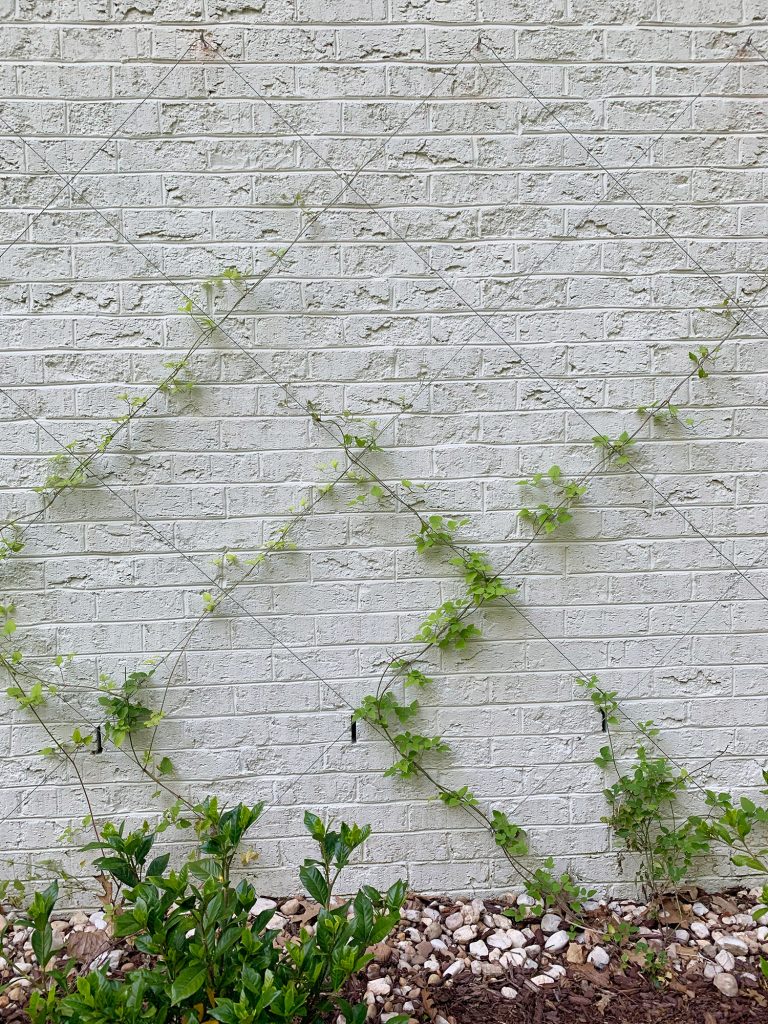
Here’s another more updated shot from a wider point of view for your viewing pleasure:
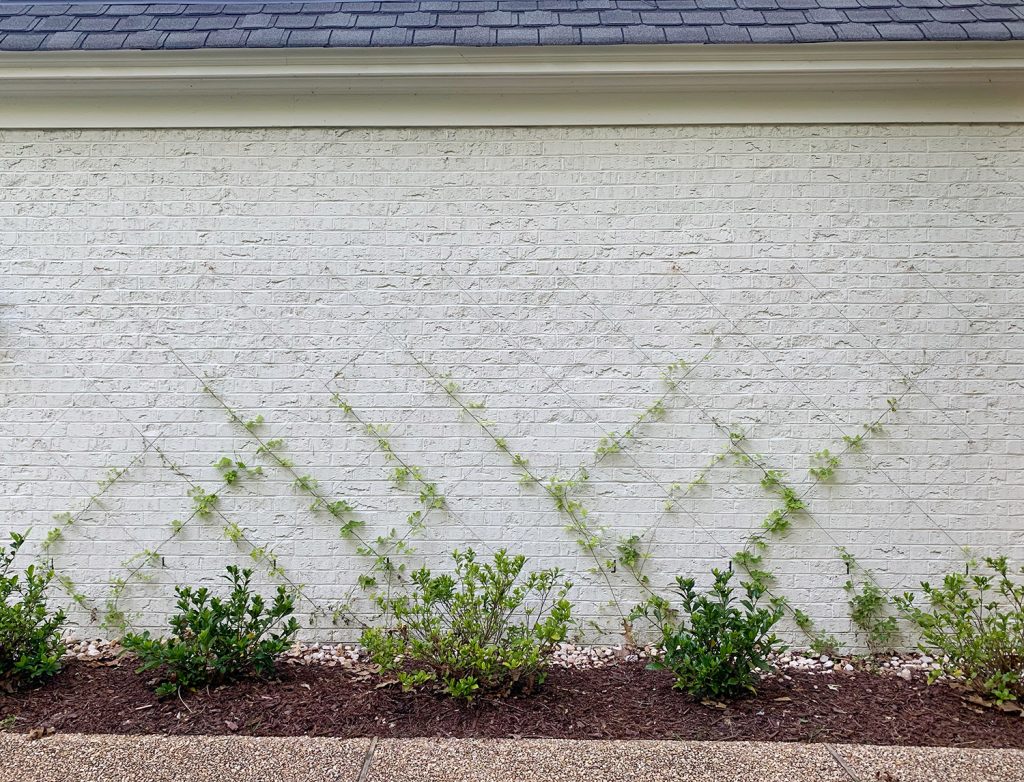
And here it is from the side so you can really see the diamond-shaped wire trellis that we created:
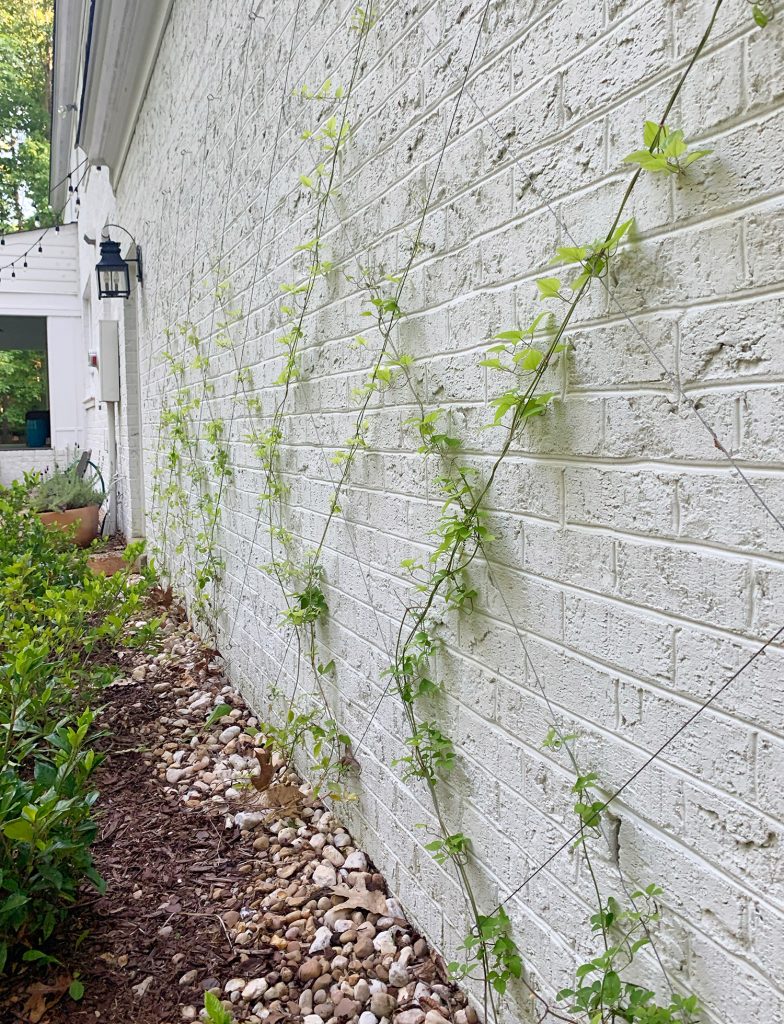
They sell some kits for installing them (like this one and this one) but we decided to buy the pieces ourselves a la cart (that was dumb, just buy the $13 kit – or two if you need more wire). You’ll also need a few basic tools (we added asterisks next to the ones that are required for brick in case you have the same setup that we do).
Materials & Tools
- 1/16th Galvanized Uncoated Steel Wire Rope (ours took three 50ft packs)
- 1/16th Aluminum Ferrules (one pack worked for us)
- Stainless Steel Screw Eye Hooks (we used 22 total)
- Brick Anchors*
- Hammer Drill with Masonry Drill Bits*
- Wire Cutters
- Needlenose Pliers
- Hammer
- Level
- Painter’s Tape
- Marker or Pen
- …and your vine! We went with clematis (I’ll talk more about that later)
*Reminder: these are items we needed because we were installing a trellis on brick. If you have some other type of siding, you may not need some of these. Like, a regular drill and drill bits should work just fine.
Planning Your Wire Trellis
The very first step for us was to figure out what we wanted our vine trellis to look like. I snapped a picture of the space and dragged it into photoshop so we could play with the scale, size, and placement of the trellis. This is something you can also figure out on paper if you don’t have the right software (heck, you can print out a photo and sketch right onto it with pencil), but I highly recommend some sort of “planning” step like this before you start making holes. We did this rendering first, and pretty quickly determined the scale felt too large for our liking (just two diamonds tall felt kinda piddly…).
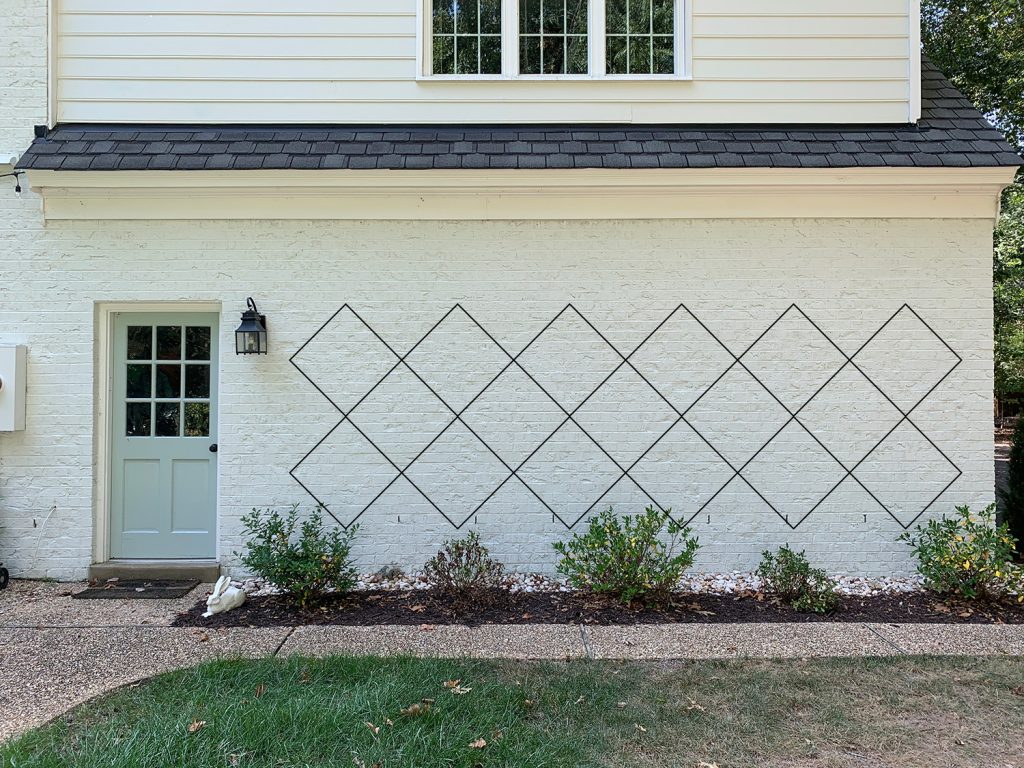
We also considered “open” diamonds on the side, but we both agreed it looked too much like an argyle sweater and the “closed” diamond shapes looked better on the ends.
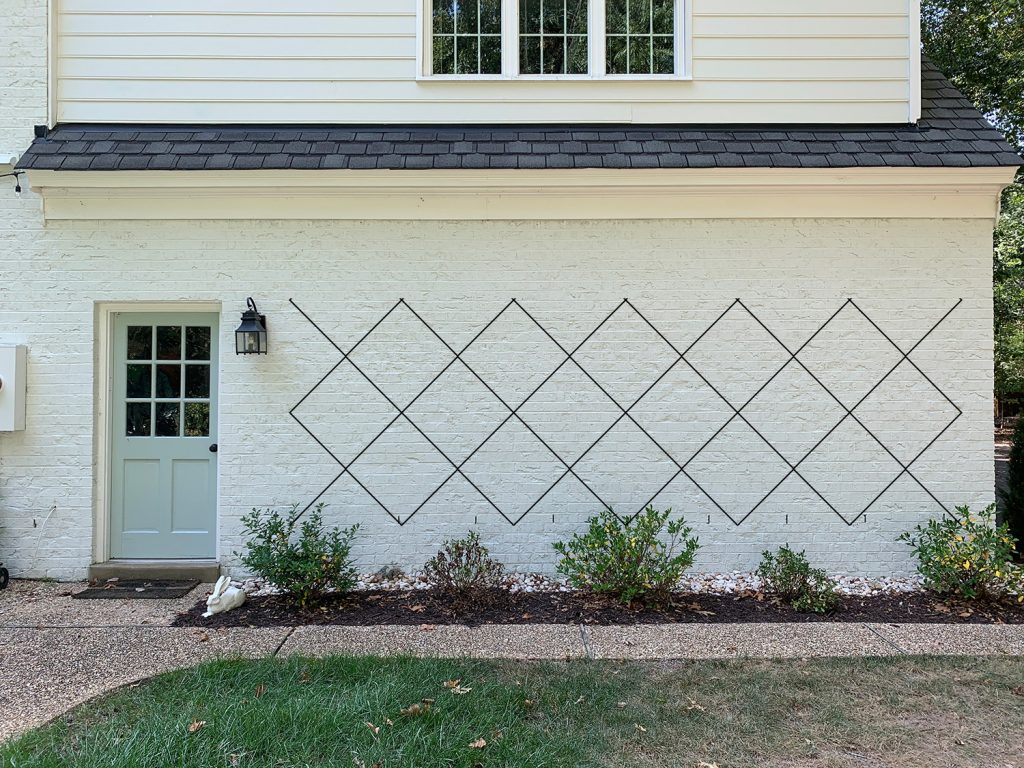
Our final design ended up being a smaller version of the first one we attempted. Thanks to this planning process, we were able to make sure it looked centered on the wall while also staying visually in line with other elements, like the door. It also helped us plan how much material we would need.
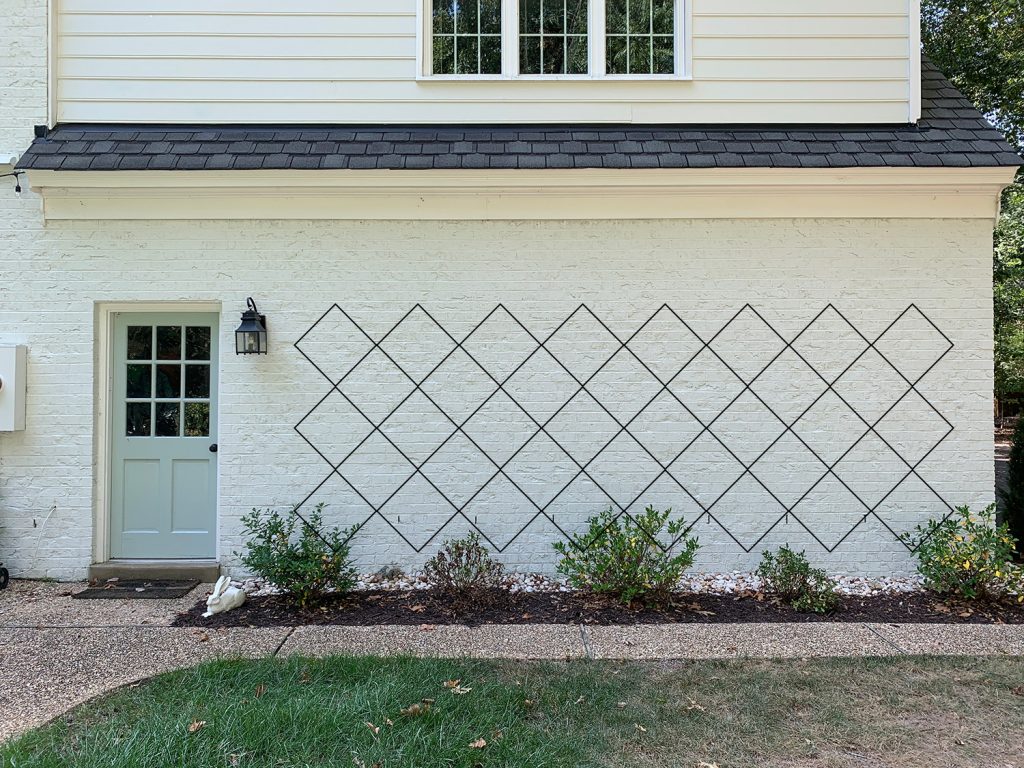
Map Out Your Pattern In Real Life
Transferring our digital mockup onto the physical wall was probably the most brain-intensive portion of this project. I wouldn’t even call it hard, it just required some concentration and double checking. We used some reference points in our photos to determine where we wanted our pattern to start on the wall and, through a little bit of trial & error, we figured out the precise measurements for each of our diamonds (ours are 25″ apart). If I were doing it again, I would’ve included a tape measure or yardstick in my original photo before photoshopping, that way we could use that for scale – but it worked out just fine without that reference point.
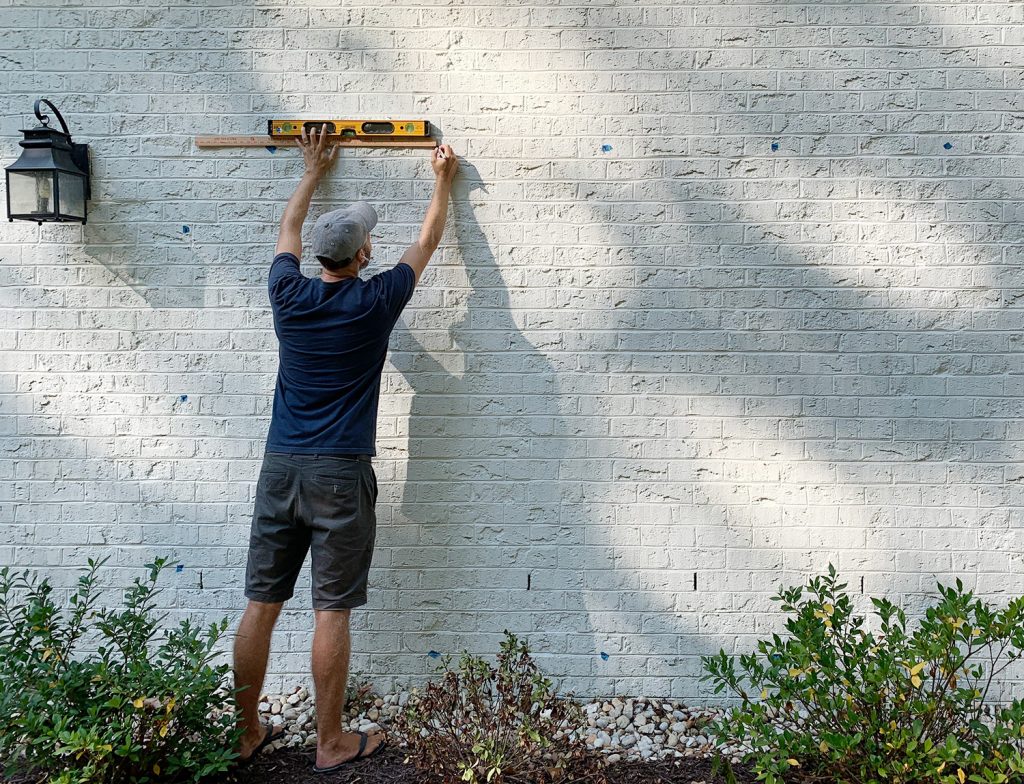
Since it was critical for our final pattern that all of our anchor points were equally spaced and totally level, we marked each anchor point with a small piece of painter’s tape and a marker dot. We didn’t want to write directly onto the brick, especially as we were fine-tuned the placement of everything.
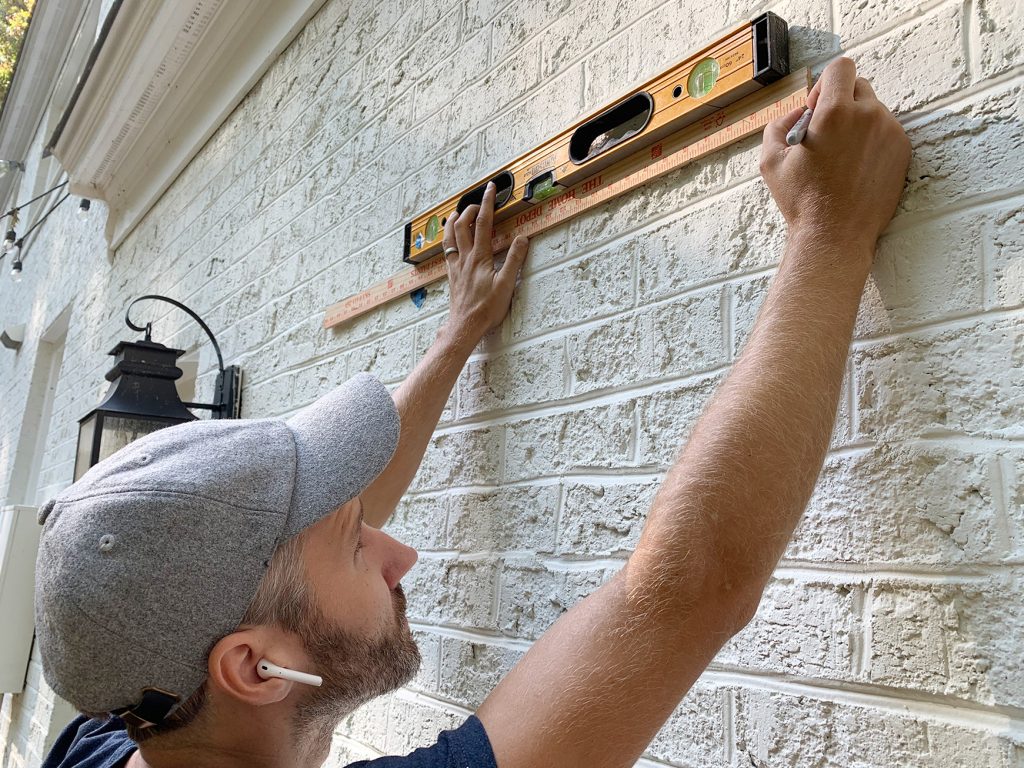
After you mark out all of your drilling spots with tape and a marker dot, it’s time to double and triple check your measurements before you drill anything. THIS IS IMPORTANT. Don’t skip this step. It’s much easier to move pieces of tape than to drill new holes and move everything because you got it wrong. We even broke out a long piece of scrap wood to make sure our top marks were exactly plumb with the bottom holes (ignore those small vertical notches in our brick along the bottom that correlate with nothing, those are some sort of garage ventilation thing and aren’t tape marks – our blue tape marks are closer to the ground and right under the dots that we taped out along the top).
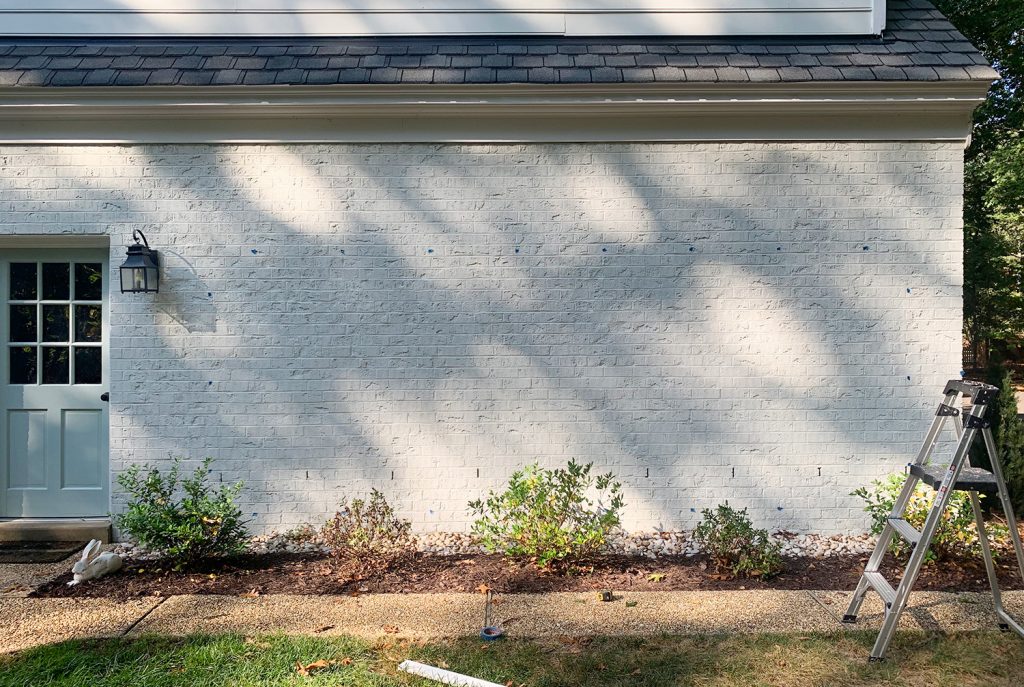
Installing Your Anchor Points
Once your spots are marked, you can get to drilling. Since we were drilling into brick, we used our hammer drill with a small masonry bit to make shallow holes through each of our tape marks, just to make a more permanent mark on the wall before any tape fell or blew off.
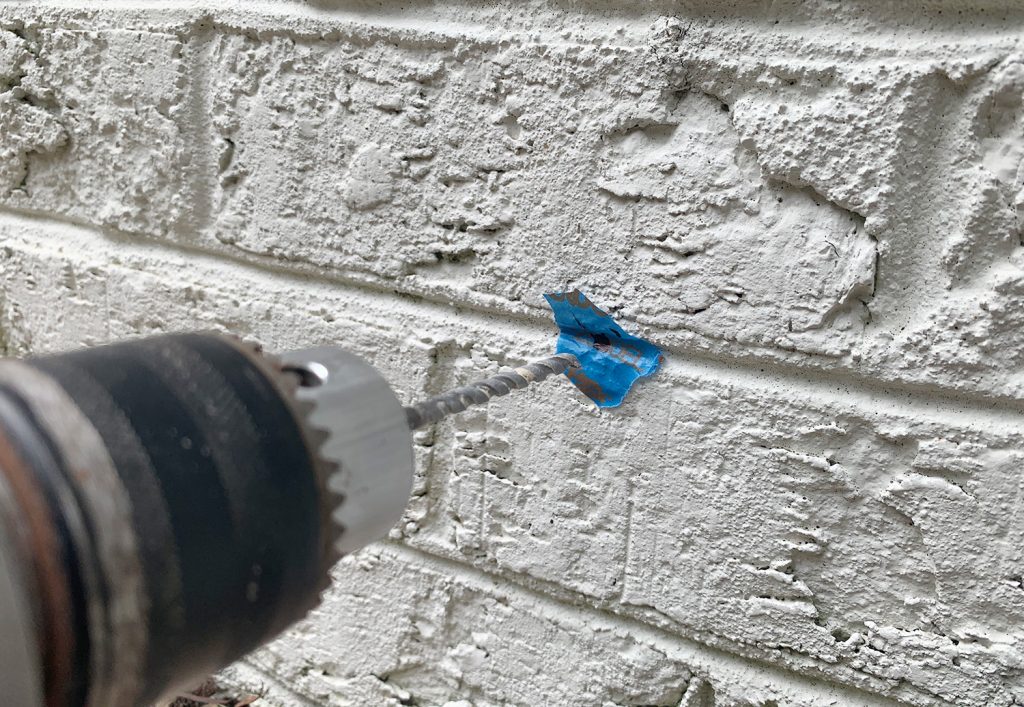
Then we went back around with a bigger bit to drill a larger and deeper hole to slip the anchors into. A hammer drill makes these easier because in addition to the spinning motion of a regular drill, it also pulses or “hammers” at the same time to chip away at materials like brick, concrete, or block.
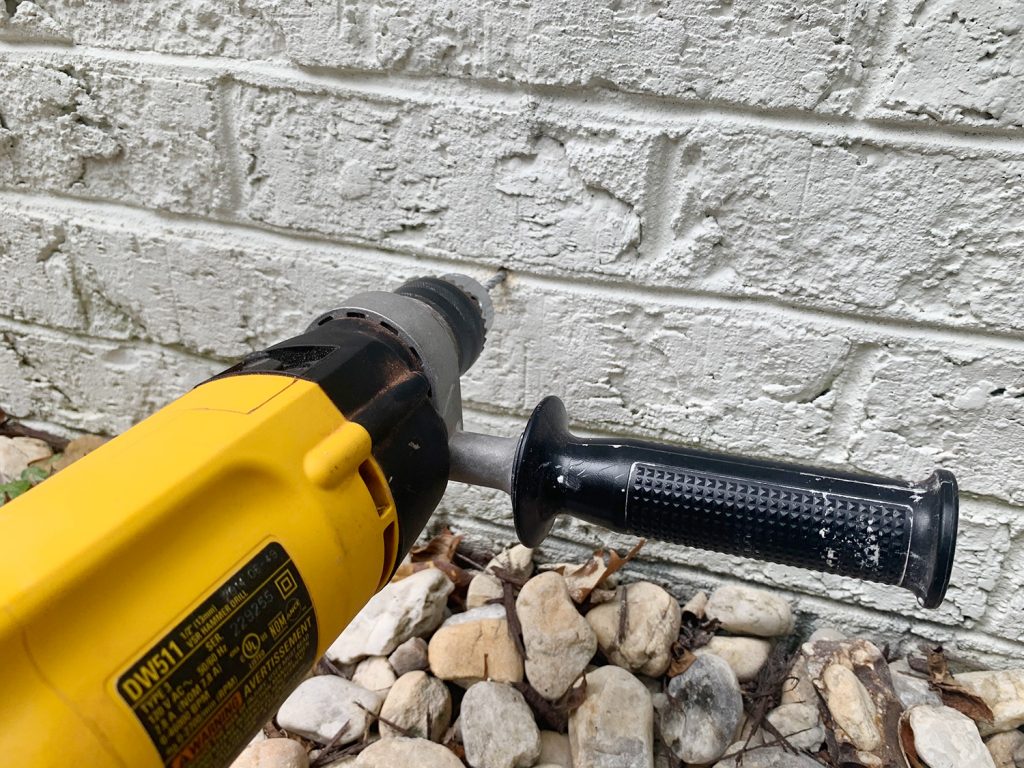
Once all of our holes were made, we went around and tapped in some plastic anchors designed for concrete and brick with a hammer. Typically I would use something like a Tapcon screw to screw something into brick, but in this case we needed something that would work with the screw eye hooks and these did the trick.
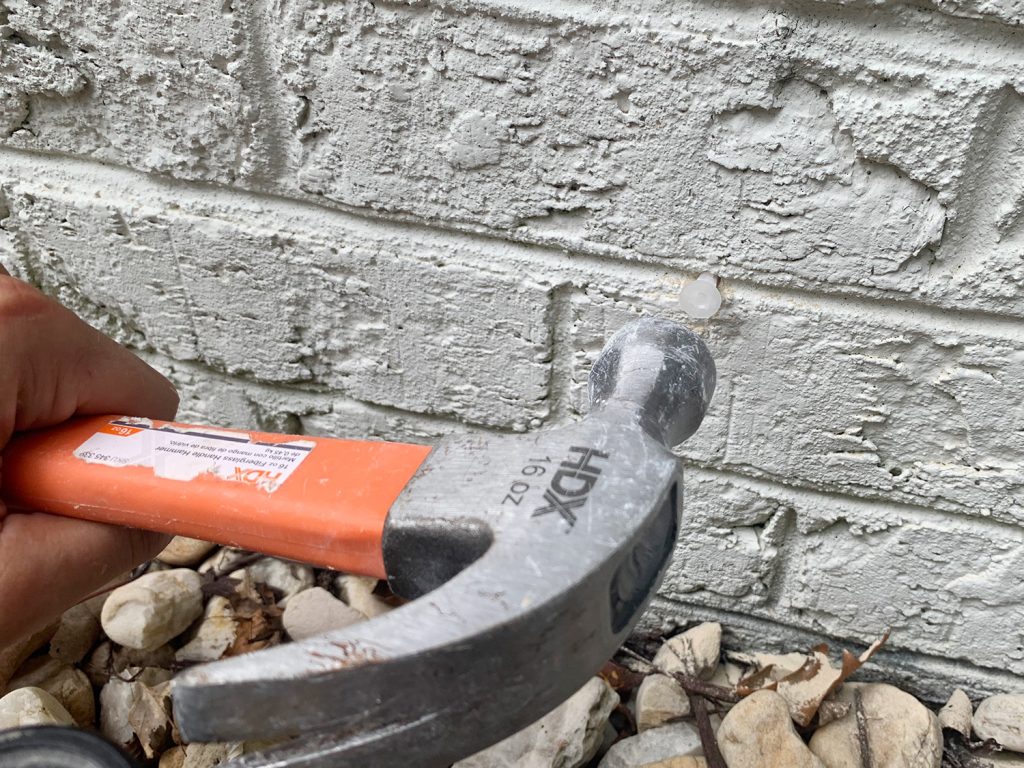
Then we went around and screwed in our eye hooks. I had trouble finding ones that (1) stuck out from the wall significantly and (2) weren’t enormous, but these 3″ puppies did the trick. The small size is helpful because it helps them visually disappear (I want your eyeballs to take in the lovely vines, not the metal hooks) and the long length will help separate our trellis from the back wall – so our plant has plenty of room to grow and wrap around the wire on both sides.
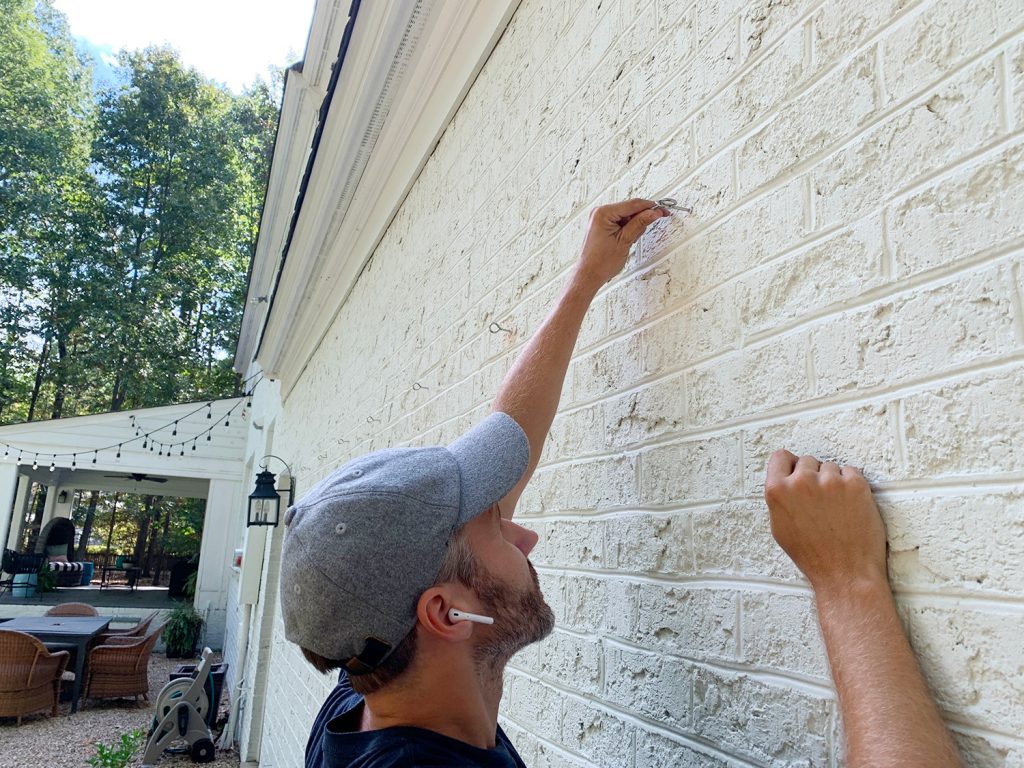
They were easy to hand tighten into the anchor at first, and towards the end we relied on a spare drill bit to give us a bit more leverage for the last few spins. These suckers are in there.
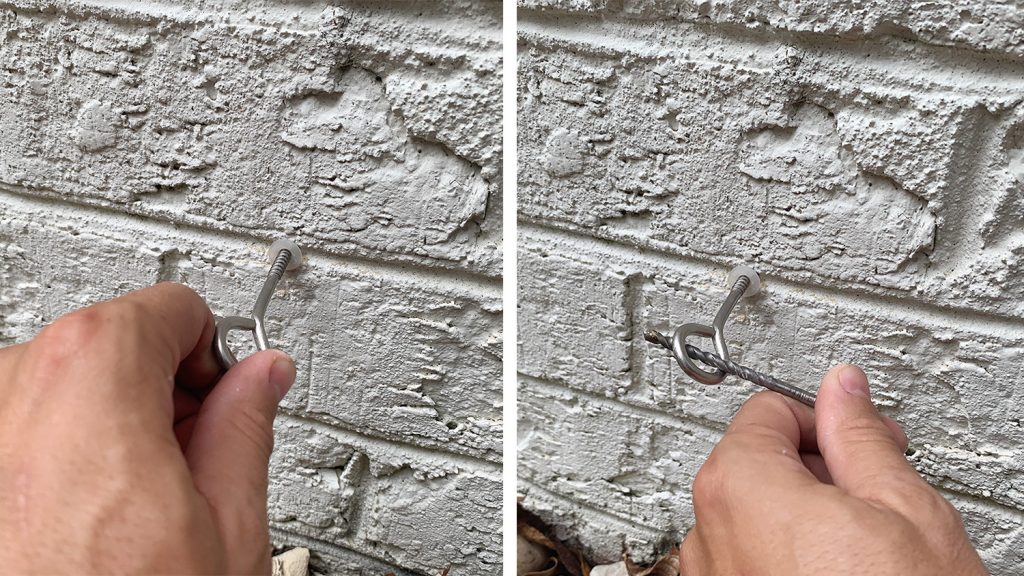
Stringing Your Wire
We were using this 1/16th galvanized steel wire rope for our trellis. We had no clue how much we’d need so rather than buy one long uninterrupted reel from the store, we bought several 50ft packs so we could more easily return any unused material. I highly recommend opening and unwinding them fully before you start attaching them, since ours often came out in a tangled mess.
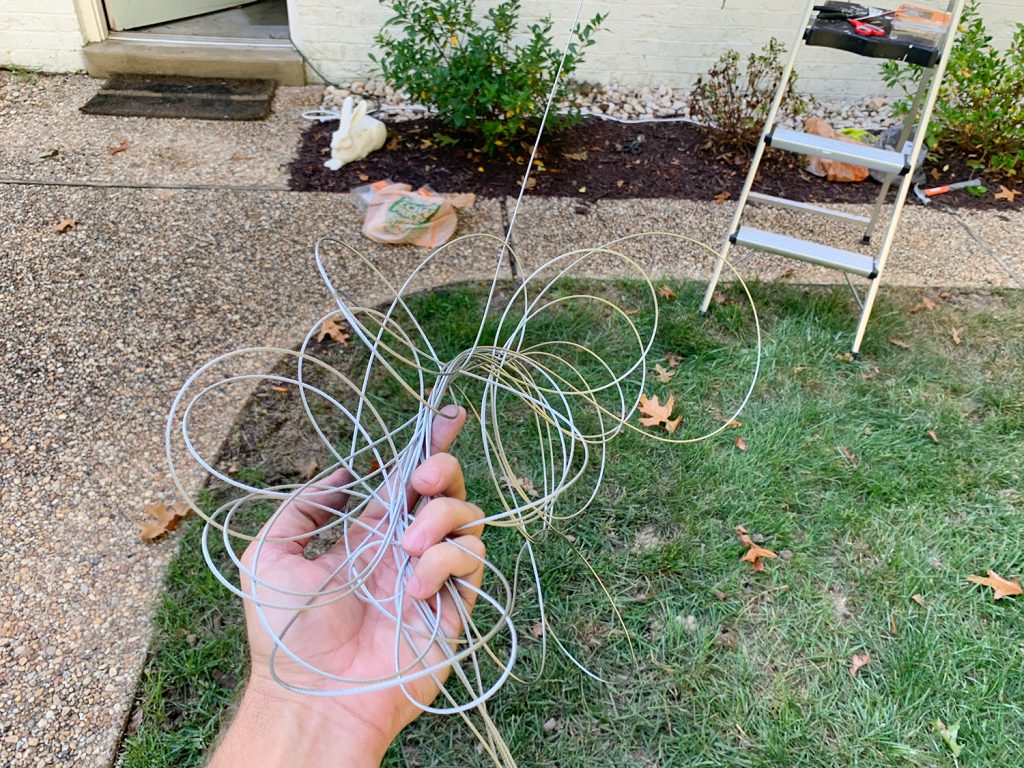
I’ll show you in a minute how we secured the end of the first wire to start the pattern, but this whole process is pretty straightforward. It’s just basically looping the wire through the pattern – up and down, side to side – making sure you’re going to the correct next eye hook. We messed this up once and started to create a wonky diamond, but it was easy enough to fix as soon as we noticed our mistake. It’s literally like putting shoe laces into a shoe. Nothing is permanent and you can step back to make sure it looks right.
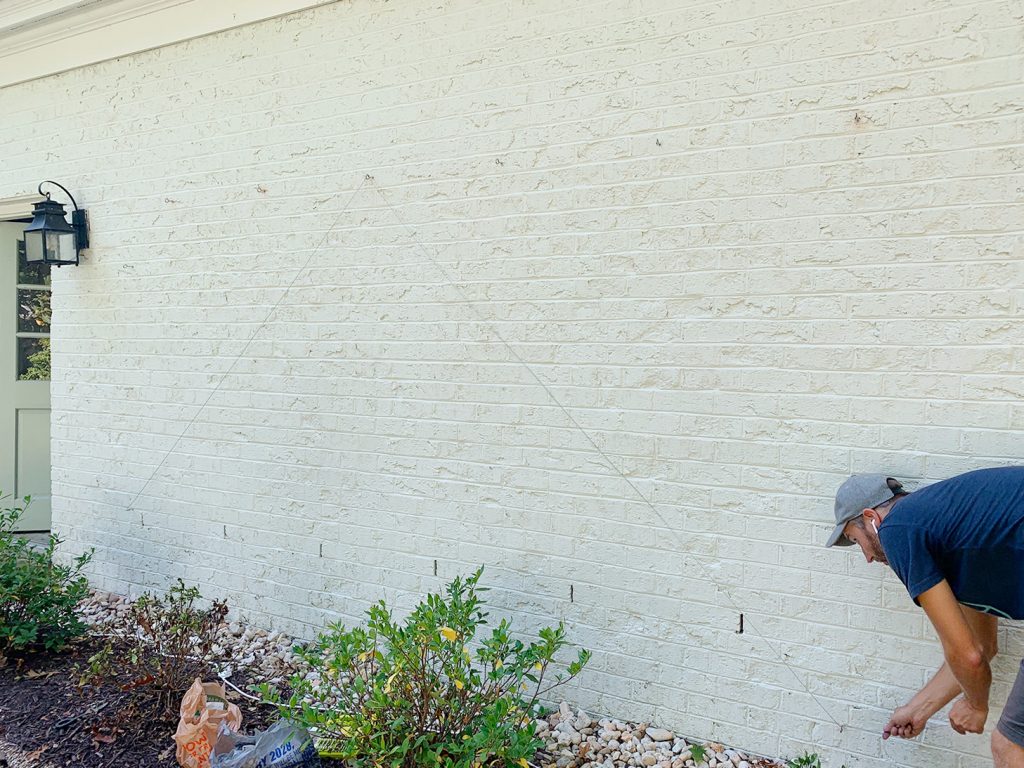
We looped the wire through each eye hook twice as we went, because that made it easier to keep the wire taut as we continued to string it through different eye hooks.
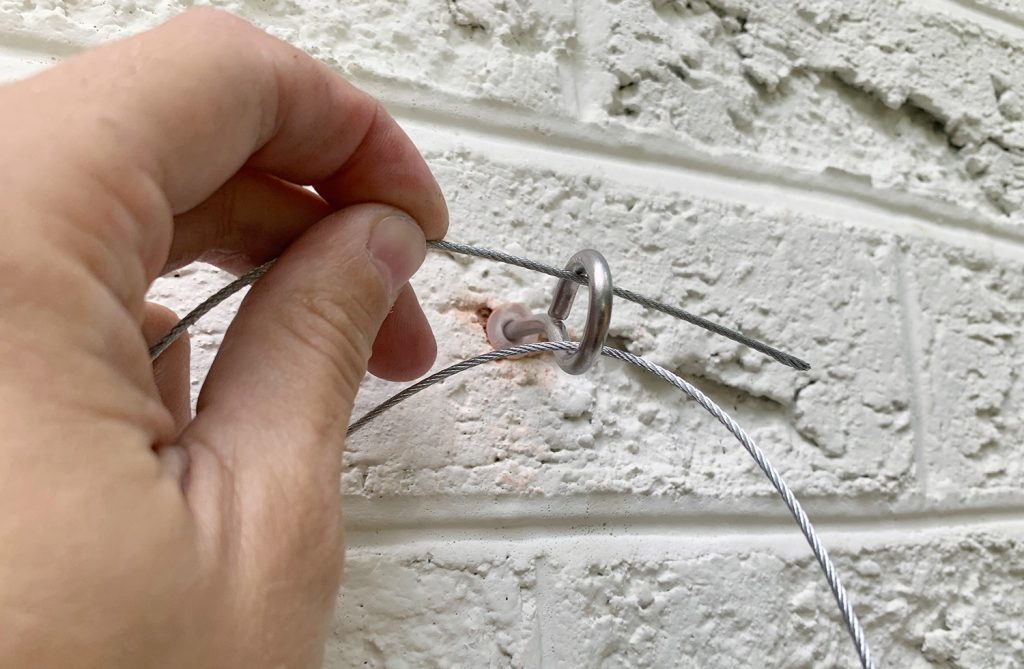
It basically looked like this as we went along. So it’s not tied in a knot, but the wire is stiff enough that it holds fairly well with a tight loop like this.
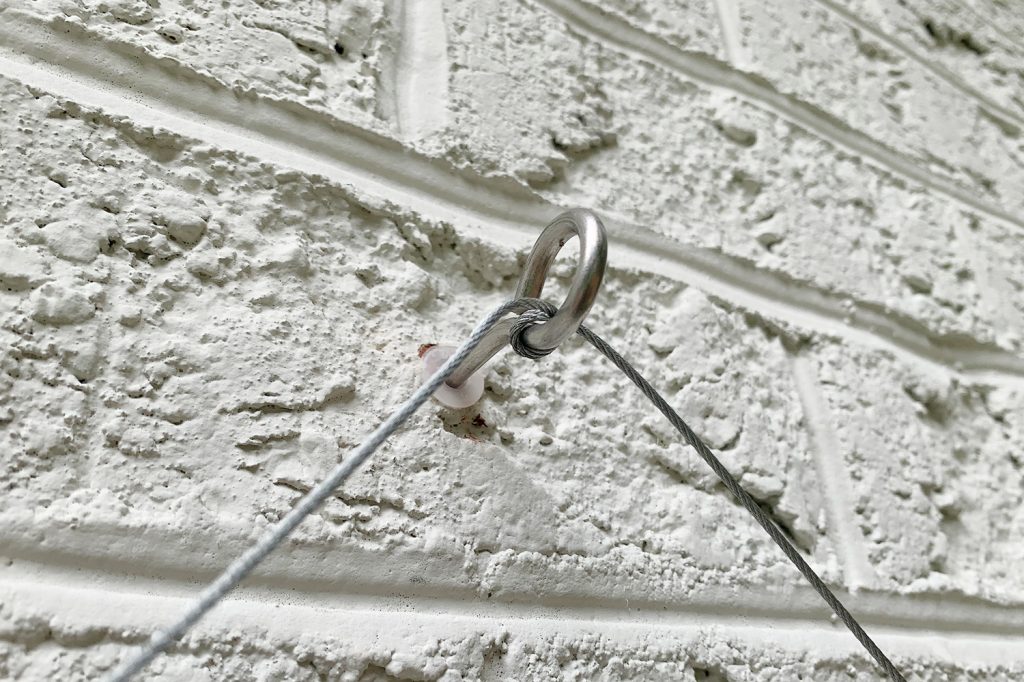
When we came to the end of one 50ft length of wire, it came time to connect a new strand. We hadn’t worked with this stuff before, but we found these aluminum ferrules to be a pretty straightforward way to accomplish this. They allow you to make these loops at the end of your wire by feeding it through one side of the ferrule and then back through the other one.
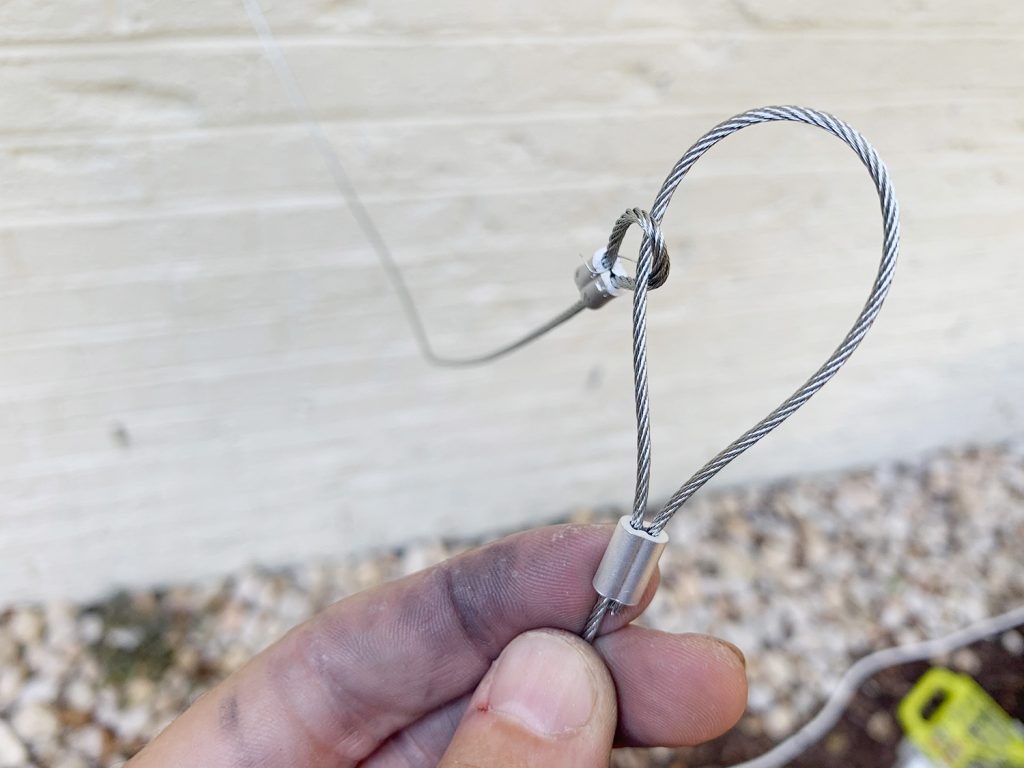
Then we just used some pliers we had on hand (well, electrical wire cutters, which had a great tip for this) to crimp the ends of the ferrule, which basically crushed them enough to hold the wire in place for the long haul. Making these small loops on the end of each wire became our go-to way to connect them into one long continuous strand.
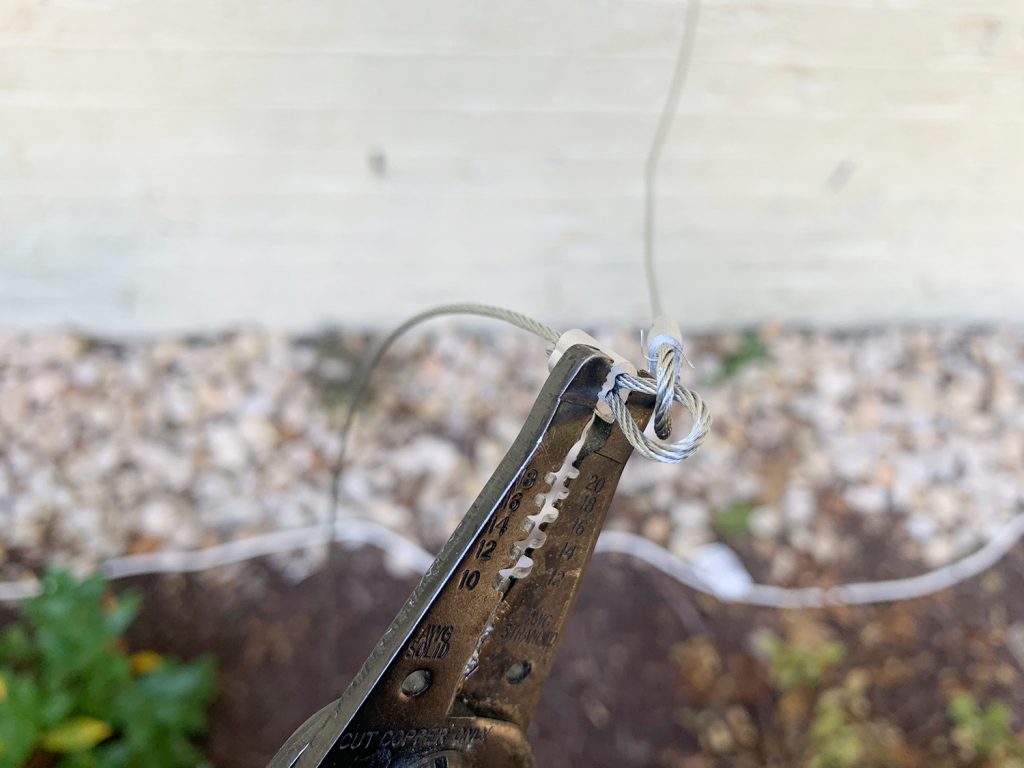
It’s also the technique we used to attach the starting end of our wire to the first anchor point and (once everything was fully threaded and pulled taut) we made another loop at the end of the wire to do the same thing.
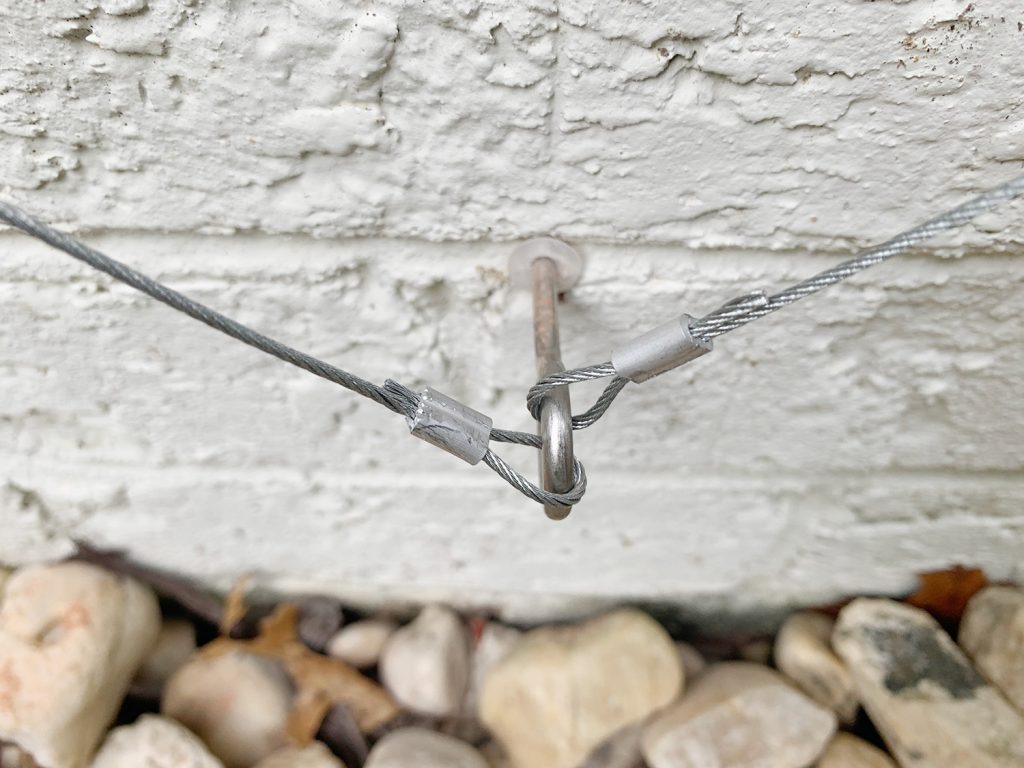
One tip for you is that in order to thread the ferrule, you need to have a very clean cut on the end of your wire. If it’s frayed it won’t slide in and you’ll stand there for 45 minutes trying to get it in there (ask me how I know). We actually had to go buy a new pair of wire cutters for this project because our old pair had become kind of blunt and it was fraying and smashing the wire to the point where it wouldn’t fit into the ferrule. So save yourself some of that frustration and make sure your wire cutters are up to snuff from the start.
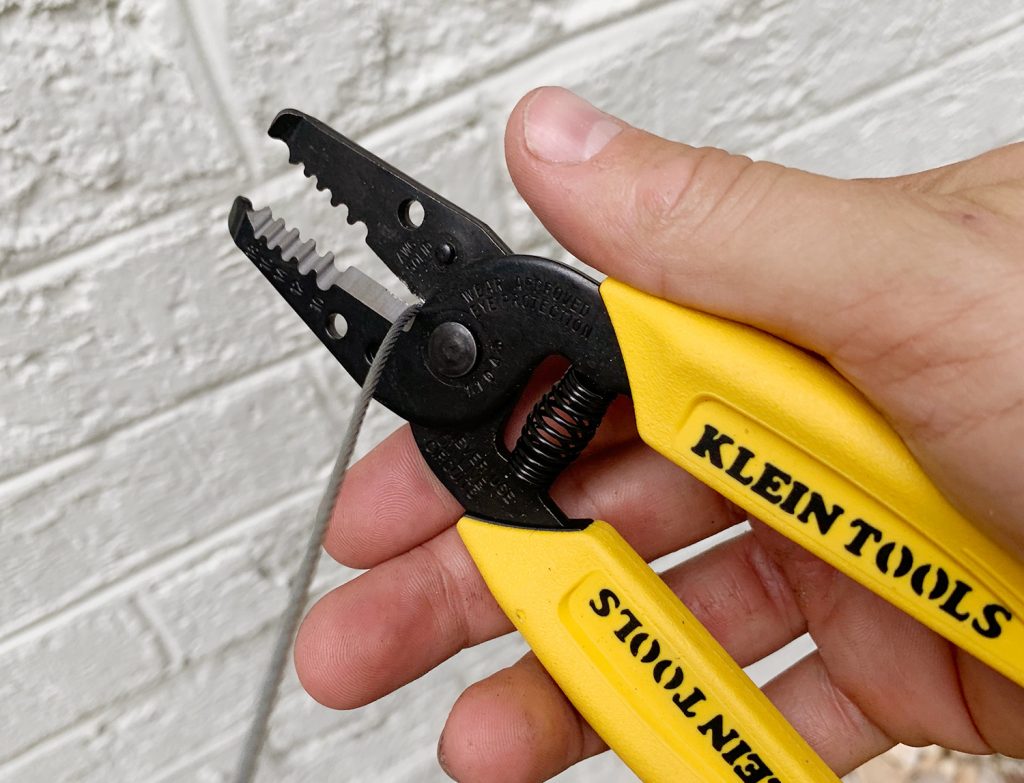
Some of the kits come with a turnbuckle that you can use to tighten your wire for maximum sustained tension. We opted not to do one for now just for simplicity’s sake, but if we find ours becoming lose over time we could always add one OR just try twisting some of the eye hooks in the brick a bit tighter to taut things up.
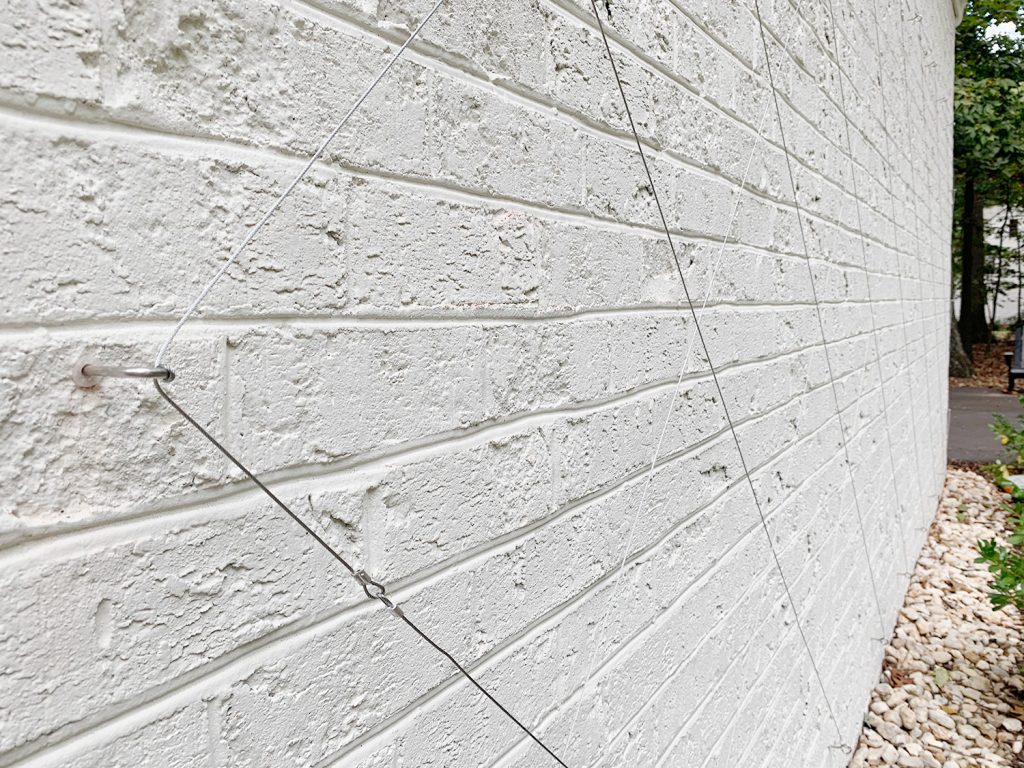
Adding Your Vining Plants
There are all sort of options for good vining plants for projects like this – especially depending on your location and conditions (for example we have deer who love to eat everything) so we spoke to two experts at our local nursery and they highly recommended clematis for our application since it’s a fast grower, it produces nice flowers, deer don’t tend to eat it in our area, and it isn’t dangerous to put near our brick (some ivies are said to be more problematic if they grow on your brick for a long time).
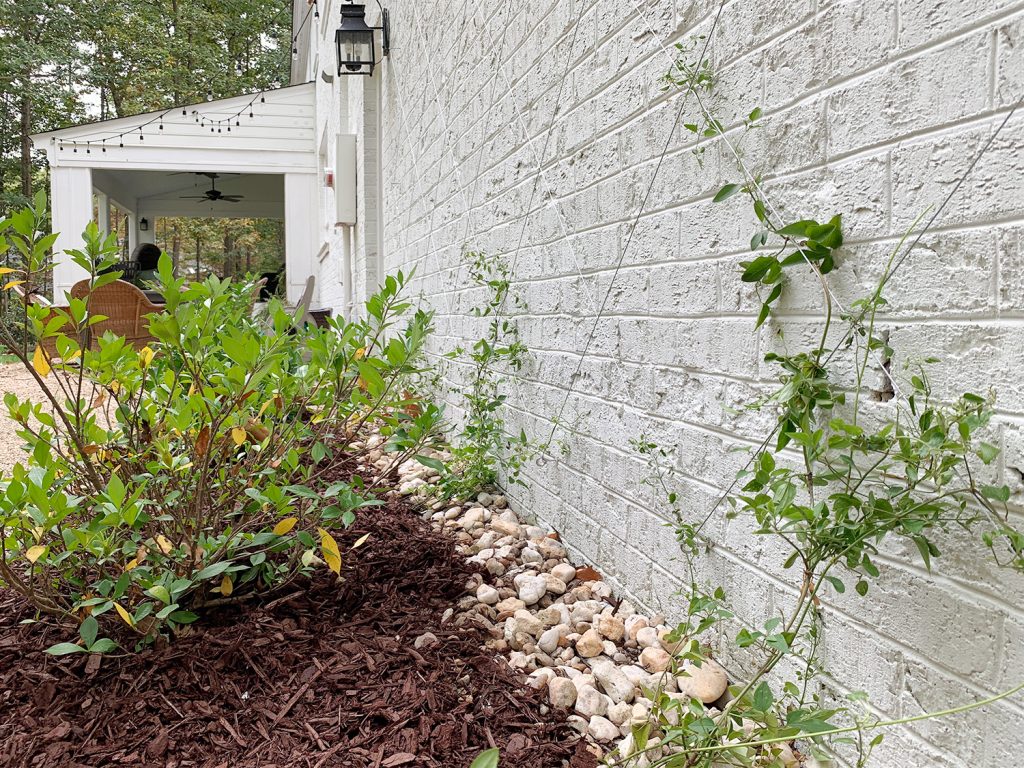
Our local nursery was running a little low on inventory so we grabbed what we could and were able to plant four vines at strategic intervals along the bottom edge of our wire trellis. After delicately unwinding them from the trellis they came with (each plant had a little metal trellis in the pot), we did our best to carefully wrap them up and around the wire in all directions.
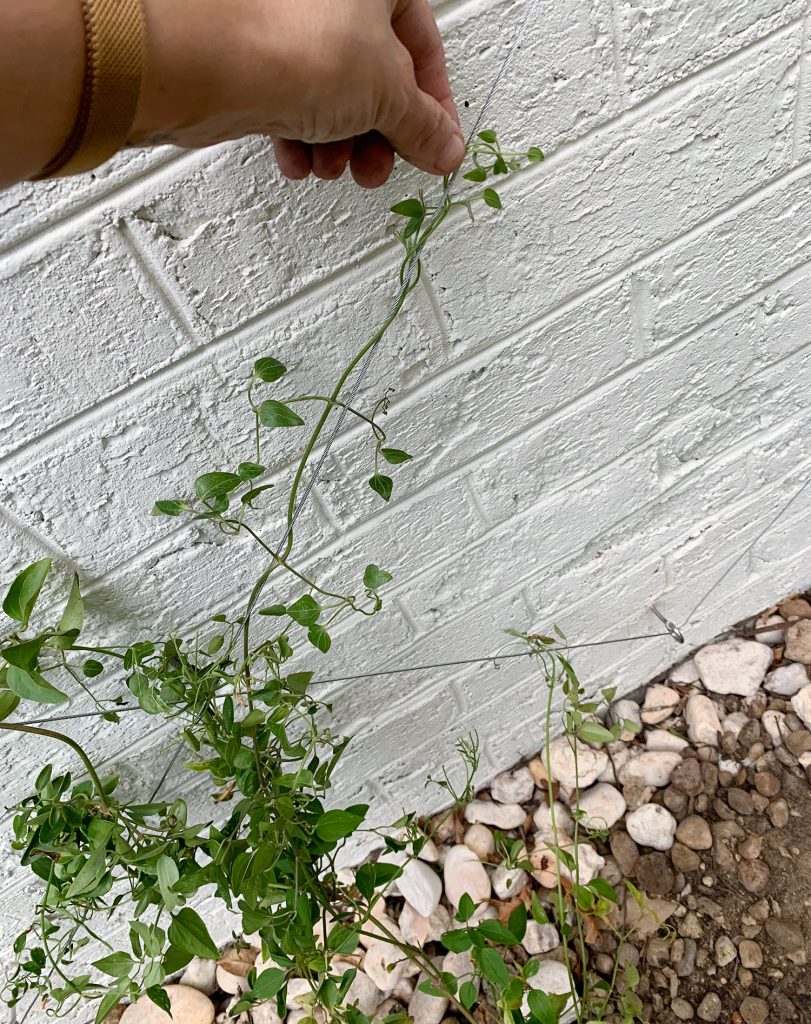
We do know that clematis is such a strong grower that the diamond pattern is something we’ll need to continue to train them to hold onto over time. If we didn’t touch them again they might just cover this entire wall with leafy vines and blooms, so we plan to keep an eye on them to make them hug the trellis shape over time. Update: actually over the next six months as they doubled or even tripled in size, they stuck to the trellis and kept their shape for the most part. So that made it nice and easy.

The last step of this project was to mulch everything, and water diligently for the next few months to establish them (it’s a good time to whisper “you grow, girl” encouragements to the vines). We also replaced a couple of dying plants in the bed, which helps the whole garden look nice and lush.
So once again, here’s a flash back to how things looked right after we made the diamond trellis and planted our vines in the fall…
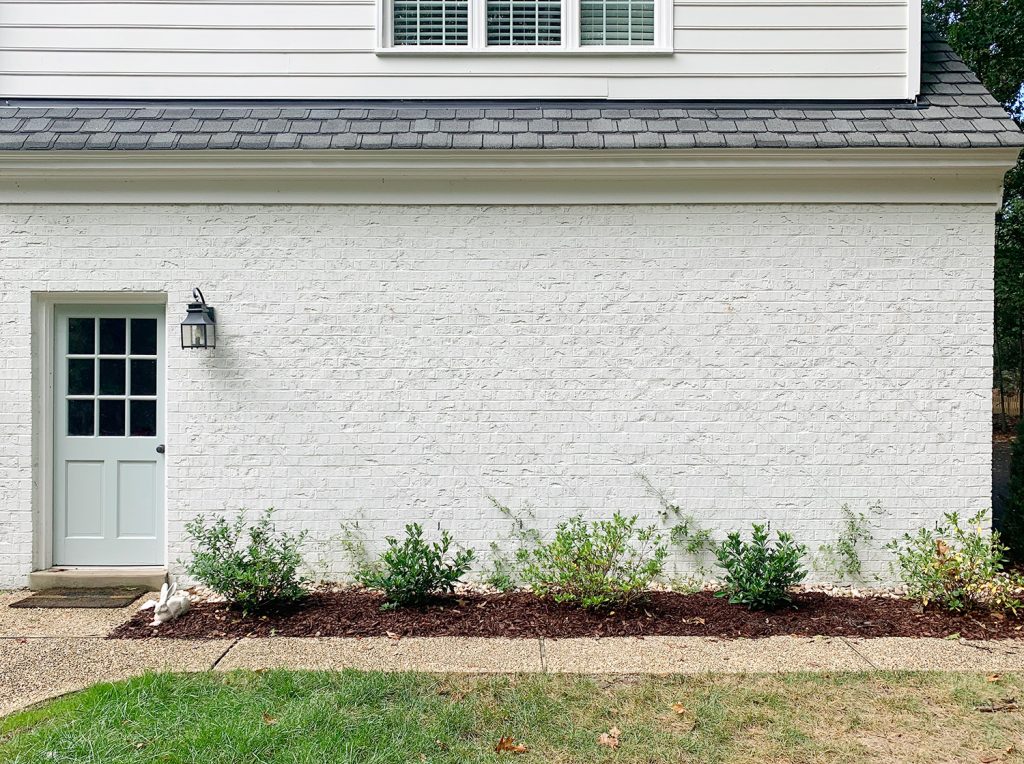
… and here’s how it looked the following spring.
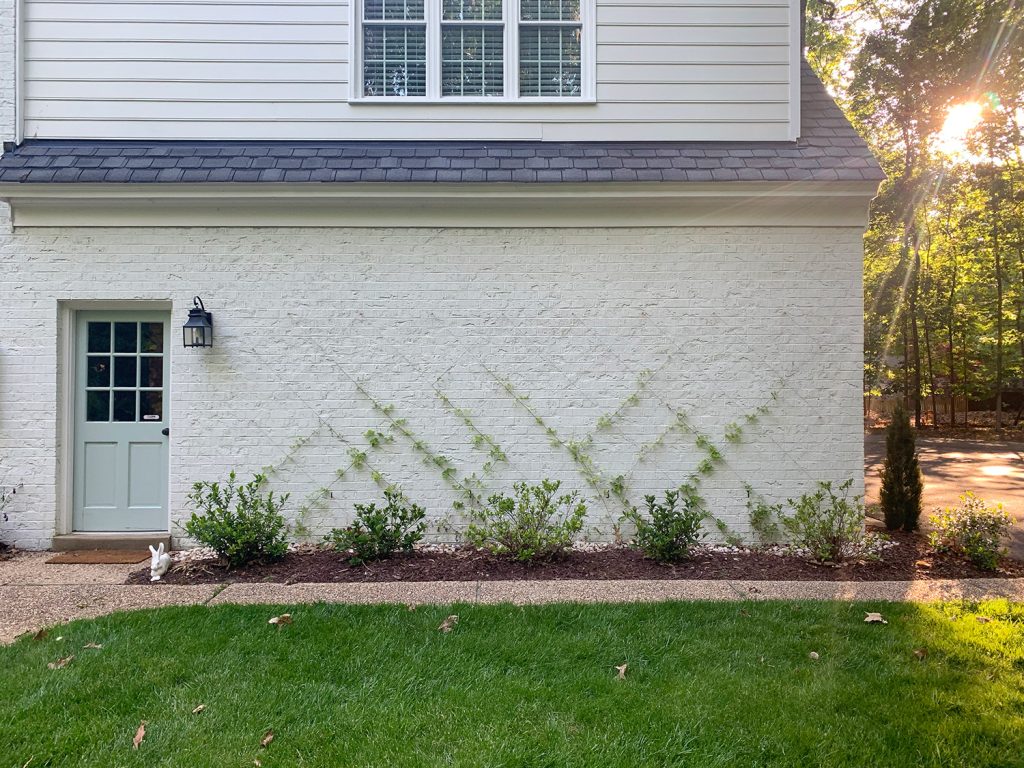
Burger sure did love botany. Look how impressed he was.
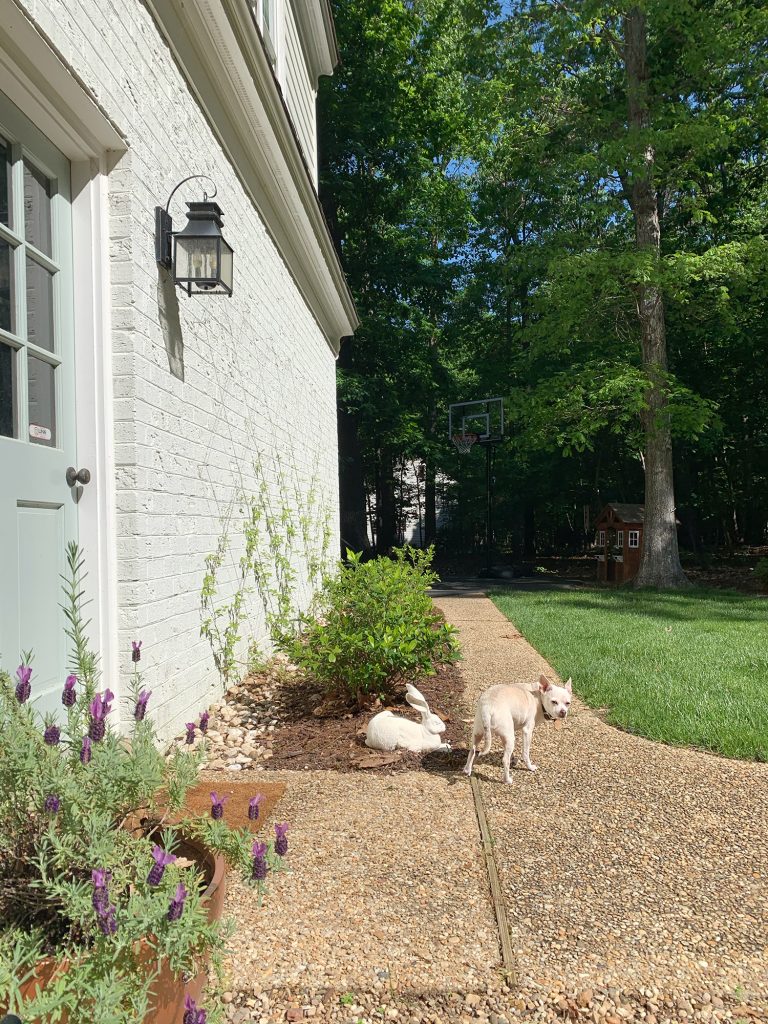
I feel like this accurate captures my enthusiams for this project. Yes, my friend made this diamond trellis cake for my birthday (and it was gone in about 2.5 hours).
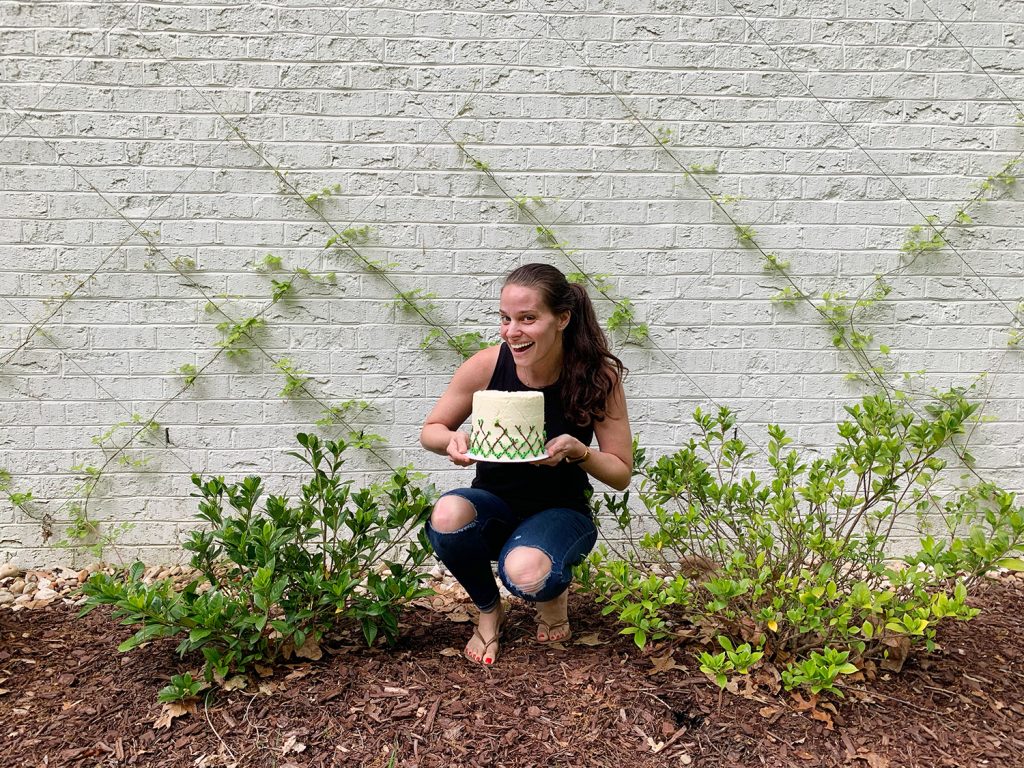
P.S. Want to see more outdoor projects we’ve tackled over the years? Here’s an entire archive full of them (from pea gravel patios & string lights & shed organization to decorative oars – ha! – it covers a lot of ground).
*This post contains affiliate links*
